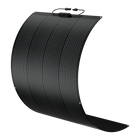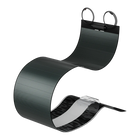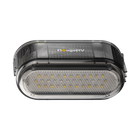How to Charge a Portable Air Conditioner?


When the summer heat becomes unbearable, a portable air conditioner can be a lifesaver. These versatile units offer the flexibility to cool different spaces without the need for permanent installation. To ensure your portable air conditioner continues to deliver optimal performance, it's crucial to understand how to charge it correctly.
In this blog, we'll walk you through the steps and tips to effectively charge a portable air conditioner, ensuring it keeps you cool and comfortable throughout the hot summer months.
Understanding Your Portable Air Conditioner
Before diving into the charging process, it's important to recognize that portable air conditioners come in two main types: electric-powered and battery-powered units. Electric-powered portable air conditioners, the most common type, are powered by plugging them into an electrical outlet or a portable power source. On the other hand, battery-powered portable air conditioners run on rechargeable batteries.
So, the method of charging will depend on whether you have an electric-powered unit or a battery-powered one. In this guide, we’ll cover both scenarios to ensure you're well-prepared.
Components to Check Before Charging
Before charging your portable air conditioner, make sure to check the following components:
-
Power Cord: Inspect the power cord for any signs of damage such as fraying or exposed wires.
-
Battery (for battery-powered units): Ensure the battery is securely connected and not damaged.
-
Ventilation: Make sure the exhaust hose is properly attached if applicable.
Regular maintenance checks can prevent potential issues during the charging process and ensure your unit runs efficiently.
Charging an Electric-Powered Portable Air Conditioner

Step 1: Find a Suitable Power Source
To begin, identify an appropriate power source. Verify that the electrical outlet or portable power station you plan to use matches the voltage requirements outlined in your portable air conditioner's user manual. While most units operate on standard household voltage (120V in the USA), it's always a good idea to double-check.
Step 2: Place the Unit Properly
Position your portable air conditioner close to the selected power outlet or power station. Make sure the exhaust hose can easily reach a window or vent to direct hot air outside. Proper positioning is essential for optimal cooling and energy efficiency.
Step 3: Connect the Power
Securely plug the power cord into the electrical outlet or portable power source.
Step 4: Turn On the Unit
Turn on the portable air conditioner using the control panel or remote control. Note that some units may take a few minutes to start cooling after being powered on. Observe the initial operation to ensure everything functions properly.
Step 5: Set the Desired Temperature
Set the temperature to your desired level. Many modern units are equipped with programmable thermostats, allowing you to set specific temperatures for different times of the day, thereby improving comfort and enhancing energy efficiency.
Charging a Battery-Powered Portable Air Conditioner
Step 1: Verify Battery Compatibility
Ensure that the battery installed in your portable air conditioner is compatible and fully functional. Refer to the user manual for specifications regarding the required battery type.
Step 2: Identify the Charging Port
Locate the charging port on your unit, typically found on the back or side of the air conditioner. It may be covered by a protective flap.
Step 3: Connect the Charger
Plug the charger into the charging port. Make sure the connection is secure to avoid any interruptions during the charging process.
Step 4: Plug into an Electrical Outlet
Connect the other end of the charger to a suitable electrical outlet. Ensure that the outlet matches the voltage requirements specified in the user manual.
Step 5: Monitor the Charging Process
Most battery-powered portable air conditioners have an indicator light or display screen to show the charging status. Keep an eye on this to ensure the battery charges fully. Charging times can vary, so refer to the user manual for specific details.
Step 6: Disconnect When Fully Charged
Once the battery is fully charged, disconnect the charger from both the unit and the electrical outlet. Avoid overcharging the battery, as this can reduce its lifespan.
Common Troubleshooting Tips
Unit Not Turning On
- Check Power Supply: Ensure the power supply is stable and the outlet is functioning.
- Inspect Cables: Verify that all cables are securely connected and not damaged.
- Reset the Unit: Some models have a reset button that can resolve minor glitches.
Inadequate Cooling
- Clean Filters: Dirty filters can restrict airflow, reducing cooling efficiency.
- Check Ventilation: Ensure the exhaust hose is not blocked or kinked.
- Inspect Seals: Make sure windows and doors are sealed to prevent warm air from entering the cooled space.
Battery Not Charging
- Secure Connections: Ensure the charger is securely connected to both the unit and the outlet.
- Check Indicator Lights: Refer to the user manual to understand what different indicator lights mean.
- Test Outlet: Plug another device into the outlet to confirm it’s working.
Safety Precautions
Handle with Care
Portable air conditioners contain refrigerants and electrical components that require careful handling. Follow all manufacturer instructions and avoid attempting repairs that might void the warranty.
Avoid Water Exposure
Keep your unit away from water sources to prevent electrical hazards. This is particularly important for battery-powered units used outdoors.
Supervise Charging
Never leave a charging unit unattended for extended periods. Overcharging can cause overheating and potential fire hazards.
Conclusion

Properly charging your portable air conditioner is crucial for maintaining its efficiency and longevity. Whether you have an electric-powered or battery-powered unit, adhering to these guidelines will help ensure it operates at peak performance, keeping you cool and comfortable during hot summer days.
By following safe charging practices, you can enjoy the many benefits of your portable air conditioner for years to come. Stay cool, stay safe, and make the most of your summer with a well-maintained portable air conditioner.




































